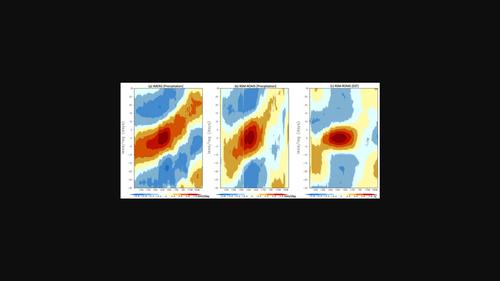Characterizing the Madden–Julian Oscillation in the western Pacific Ocean from a regional coupled ocean–atmosphere model simulation
IF 3
3区 地球科学
Q2 METEOROLOGY & ATMOSPHERIC SCIENCES
引用次数: 0
Abstract
This study reports on the analysis of the results from a 20 km grid spacing, Regional Coupled ocean–atmosphere Model (RCM) integration over the Western Pacific Warm Pool (WP2). The RCM was integrated over a 20-year period (1986–2005) using reanalysis boundary conditions for the atmosphere and the ocean. This is a first-of-a-kind study with an RCM at 20 km over the WP2. The RCM simulation shows reasonable fidelity of the mean state and of the Madden–Julian Oscillation (MJO). We utilize this successful integration of the RCM to understand a well-known observed feature of MJOs in the WP2 to be of the strongest amplitude during the December–March period of the year. Our analysis of the model integration reveals that the recharge of moist static energy (MSE) prior to peak MJO convection and its discharge during and after the convection explains the MJO in the simulation. The recharge/discharge of the MSE is shown to be largely dictated by horizontal advection, which is stemmed to a small extent by column-integrated radiative heating and surface evaporation. This balance of forces in the evolution of the MSE anomalies and their corresponding variations with sea-surface temperature (SST) anomalies at MJO time-scales in the WP2 is strongest in the December–March period in the RCM simulation.

从区域海洋-大气耦合模式模拟西太平洋马登-朱利安涛动的特征
本文报道了对西太平洋暖池(WP2) 20 km网格间距区域耦合海-气模式(RCM)积分结果的分析。利用再分析大气和海洋的边界条件,对20年期间(1986-2005年)的RCM进行了综合。这是首次在WP2上空20公里处进行RCM研究。RCM仿真显示了平均状态和MJO的保真度。我们利用RCM的成功整合来理解WP2中mjo的一个众所周知的观测特征,即在每年的12月至3月期间振幅最强。对模型积分的分析表明,对流高峰期前湿润静态能(MSE)的补给以及对流期间和对流后湿润静态能的释放可以解释模拟中的MJO。MSE的补给/排放主要由水平平流决定,而水平平流在一定程度上受柱积分辐射加热和地表蒸发的影响。在RCM模拟中,WP2 MJO时间尺度上MSE距平及其与海温距平变化的平衡在12月- 3月期间最强。
本文章由计算机程序翻译,如有差异,请以英文原文为准。
求助全文
约1分钟内获得全文
求助全文
来源期刊
CiteScore
16.80
自引率
4.50%
发文量
163
审稿时长
3-8 weeks
期刊介绍:
The Quarterly Journal of the Royal Meteorological Society is a journal published by the Royal Meteorological Society. It aims to communicate and document new research in the atmospheric sciences and related fields. The journal is considered one of the leading publications in meteorology worldwide. It accepts articles, comprehensive review articles, and comments on published papers. It is published eight times a year, with additional special issues.
The Quarterly Journal has a wide readership of scientists in the atmospheric and related fields. It is indexed and abstracted in various databases, including Advanced Polymers Abstracts, Agricultural Engineering Abstracts, CAB Abstracts, CABDirect, COMPENDEX, CSA Civil Engineering Abstracts, Earthquake Engineering Abstracts, Engineered Materials Abstracts, Science Citation Index, SCOPUS, Web of Science, and more.

 求助内容:
求助内容: 应助结果提醒方式:
应助结果提醒方式:


